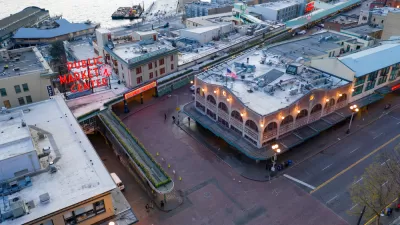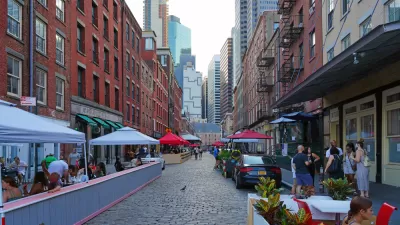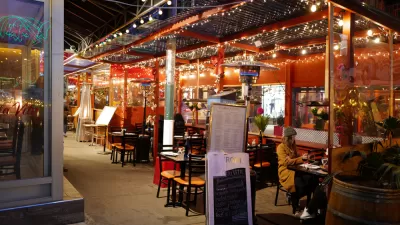Started as a response to pandemic restrictions, al fresco dining has taken off as customers, restaurant owners, and city officials realize the social and economic benefits of outdoor dining spaces.

In a paywalled article in the Boston Globe, Yvonne Abraham describes the persistent popularity of the outdoor dining programs that proliferated during the pandemic. As Abraham points out, “The trend is evolving well beyond the stopgap measures of construction barriers and plastic cones. Five-star hotels and Michelin-starred restaurants are transforming it from shabby to chic.”
And the form is evolving: “It’s taking the form of pop-ups, picnics, cocktail gardens, and poolside dining. Gourmet cuisine is being offered up in caves, heated yurts, and converted ski gondolas, and on tables in the shallows of the ocean.” Restaurants are making creative use of nearby spaces to create entirely unique experiences and an added draw for tourists.
According to the National Restaurant Association, forty percent of consumers say they’re more likely to choose a restaurant with outdoor seating. Many restaurants that began with temporary seating installations that were broken down at the end of the night are shifting to more permanent designs. Even as fears of COVID-19 subside, customers seem to enjoy the diversity of options offered by al fresco dining, and cities have started to extend programs slated for termination and relax rules related to outdoor dining facilities.
FULL STORY: Pull up a chair: Outdoor dining isn't going anywhere

Maui's Vacation Rental Debate Turns Ugly
Verbal attacks, misinformation campaigns and fistfights plague a high-stakes debate to convert thousands of vacation rentals into long-term housing.

Planetizen Federal Action Tracker
A weekly monitor of how Trump’s orders and actions are impacting planners and planning in America.

In Urban Planning, AI Prompting Could be the New Design Thinking
Creativity has long been key to great urban design. What if we see AI as our new creative partner?

Baker Creek Pavilion: Blending Nature and Architecture in Knoxville
Knoxville’s urban wilderness planning initiative unveils the "Baker Creek Pavilion" to increase the city's access to green spaces.

Pedestrian Deaths Drop, Remain Twice as High as in 2009
Fatalities declined by 4 percent in 2024, but the U.S. is still nowhere close to ‘Vision Zero.’

King County Supportive Housing Program Offers Hope for Unhoused Residents
The county is taking a ‘Housing First’ approach that prioritizes getting people into housing, then offering wraparound supportive services.
Urban Design for Planners 1: Software Tools
This six-course series explores essential urban design concepts using open source software and equips planners with the tools they need to participate fully in the urban design process.
Planning for Universal Design
Learn the tools for implementing Universal Design in planning regulations.
planning NEXT
Appalachian Highlands Housing Partners
Mpact (founded as Rail~Volution)
City of Camden Redevelopment Agency
City of Astoria
City of Portland
City of Laramie





























